#Peru Mummy
Explore tagged Tumblr posts
Text
Peru police find pre-Hispanic mummy in ex-delivery man's bag

Police in Peru have seized a mummified human, between 600 and 800 years old, from a former food delivery man who claimed to have had it at his home for three decades.
The mummy was in the isothermal bag the man had once used to deliver food to people's homes.
The man, 26-year-old Julio Cesar Bermejo, will remain in detention while investigators look into the case, a government official told AFP on Tuesday.
Bermejo told local media the mummy, who he called "Juanita," was "like my spiritual girlfriend."
"At home, she's in my room, she sleeps with me. I take care of her," he said in a video that went viral on social media. Read more.
2K notes
·
View notes
Text
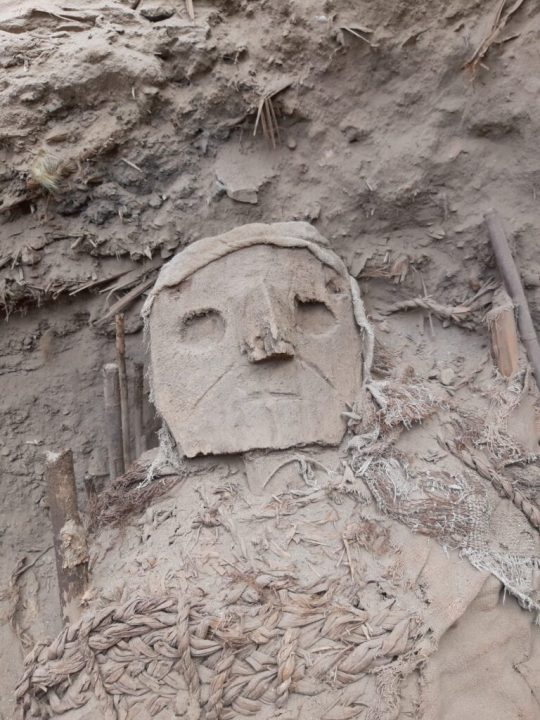

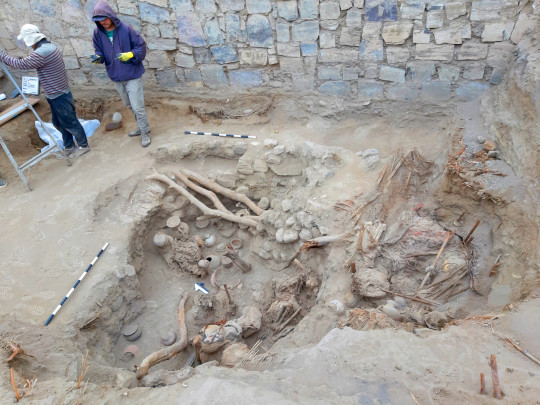

Archaeologists Find 73 Wari Mummy Bundles in Peru
A team of archaeologists from the PUCP Archaeology Program “Valley of Pachacámac” have uncovered over 70 intact burial bundles with carved masks.
The discovery was made at Pachacámac, an archaeological site in the Valley of the Lurín River, located southeast of Lima, Peru. Pachacámac (named after Pacha Kamaq – the “Earth Maker” creator god) was first settled around AD 200 by the Wari, a Middle Horizon civilisation.
Pachacámac mainly consists of pyramids, plazas, cemeteries, and a series of ramps, centred on a sacred zone containing the Painted Temple, the Temple of the Sun, and the Old Temple of Pachacamac.
Recent excavation results announced on the Archeowieści blog, which is managed by the Faculty of Archaeology of the University of Warsaw, have uncovered over 70 intact burial bundles dating from the second half of the Middle Horizon (AD 800–1100).
The burial bundles were found either deposited individually or in group clusters at the foot of the Painted Temple, some of which are wearing “false head” masks made of carved wood and ceramics, a common burial practice of the Wari culture.

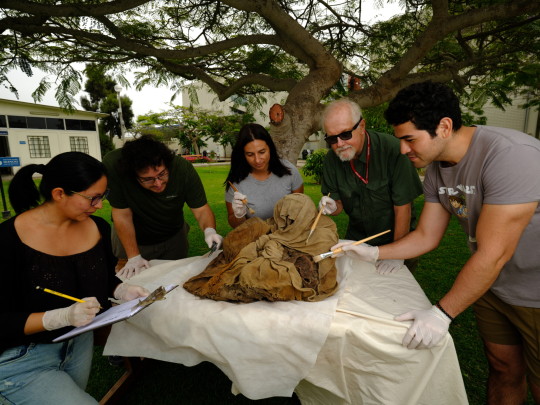
Professor Makowski, said: “In the pre-Hispanic Andes, no-one died; everyone was predestined to continue living in the parallel world of their ancestors.”
Excavations also discovered wooden staffs with images of Wari elite wearing Tiwanaku-type headgear. They were located in a votive deposit covered with a layer of oyster shell fragments imported from Ecuador.


The Wari worshipped the Staff god, the chief creator god, which is often found in both portable and fixed art using different media such as stone, textile, and ceramics. Some scholars believe that some variations of the Staff God are possible depictions of Viracocha or Thunupa, and are the forerunner of the Inca principal gods – the Sun, Moon, and Thunder.
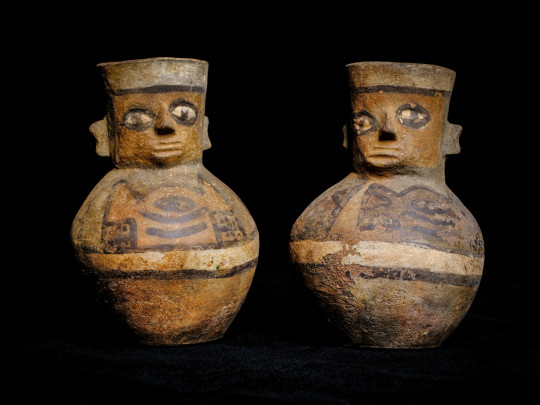

#Archaeologists Find 73 Wari Mummy Bundles in Peru#Pachacámac#ancient graves#ancient tombs#grave goods#ancient artifacts#archeology#archeolgst#history#history news#ancient history#ancient culture#ancient civilizations#wari
59 notes
·
View notes
Text
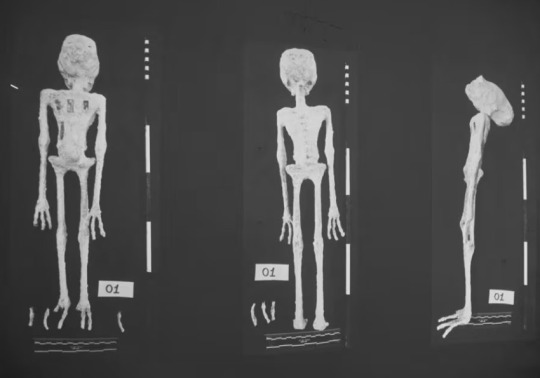
"Scientists assert 'alien mummies' in Peru are really dolls made from Earthly bones"
And I had been wishing it were true...
#news#peru#aliens#mummies#hoaxes#reuters#alien mummies#skeletons#south america#xrays#science#macabre#skulls#dolls
42 notes
·
View notes
Text

🥴♥️
#tad the lost explorer#tadeo jones#tadeo jones 2#tadeo jones 3#mediaset#españa#indiana jones#parodia#parody#luz noceda#toh luz#straight#romantic#the mummy#momia#peru#drawing#hand drawings#pencil drawing#fanart#fan comic#fyp#viral
5 notes
·
View notes
Text

📍huaca pucllana, lima, perú. 19 de diciembre de 2018.
3 notes
·
View notes
Text
Necropoli de Chauchilla, Peru
Necrópolis de Chauchilla, Perú
Necropoli di Chauchilla, Perú


(English / Español / Italiano)
It is a pre-Inca necropolis. Some sources link it to the ancient Huari culture and others to the Nazca culture, which flourished in the area between the 2nd century BC and the 9th century AD.
The mummies are in a good state of preservation despite their age, and many of them still show traces of hair and even some skin. Preservation has been made possible in part by the arid climate of the Nazca desert in which the cemetery is located. It is the only Peruvian archaeological site where the mummies can be seen in their original tombs.
-----------------------------------------------------------------------------
Se trata de una necrópolis de época preincaica. Algunas fuentes la relacionan con la antigua Cultura Huari y otras con la Cultura Nazca que florecieron en la zona entre el siglo II a. C. al siglo IX de nuestra era.
Las momias están en un buen estado de conservación a pesar de su antigüedad y en muchas de ellas se pueden ver aún restos de cabellos e incluso algo de piel. La conservación ha sido posible en parte gracias al clima árido del desierto de Nazca en el que se encuentra enclavado el cementerio. Se trata del único sitio arqueológico peruano en el que las momias se pueden ver en sus tumbas originales.
------------------------------------------------------------------------------
Si tratta di una necropoli pre-Inca. Alcune fonti la collegano all'antica cultura Huari e altre alla cultura Nazca, che fiorì nella zona tra il II secolo a.C. e il IX secolo d.C..
Nonostante l'età, le mummie sono in buone condizioni: molte mostrano tracce di capelli e persino di pelle. Questa conservazione è stata resa possibile in parte dal clima arido del deserto di Nazca, dove si trova il cimitero. È l'unico sito archeologico peruviano in cui è possibile vedere le mummie nelle loro tombe originali.
Source: Curiosidades universales y algo más
#middle ages#edad media#medievo#2nd century bc#9th century AD#s. II a.C.#s.IX d.C.#nazca#peru#huari#chauchilla#mummie#momias#mummies
3 notes
·
View notes
Text
dailymotion
Two new 'alien mummies' and an 'alien skull' documented in Peru
#alien#mummies#discovered#peru#mystery#fossilized#alien mummy#origins#alien skull#read#more#presser#descends#into#chaos#police#raid#event#case#perus#mysterious#continues#deepen#footage#depicting#three#apparent#creatures#including#severed
3 notes
·
View notes
Text

Retrieve April 30th 2024


3 notes
·
View notes
Video
youtube
Cruise Ship Accused of Keeping Dead Body in Beverage Cooler
and peru
0 notes
Text
The Revelation of Time
What will it be like when we die? What holds the answer?
Daily writing promptWhich topics would you like to be more informed about?View all responses What will it be like when we die? I’m sure all of us have asked that question to ourselves at least once. The mysteries of the afterlife has intrigued many for decades. Each creating their own version of what would happen and how to prepare for the afterlife. For example, Egyptians creating tombs and…

View On WordPress
#afterlife#americans#believer#cochlear implant#dailyprompt#dailyprompt-2066#deaf#egyptains#information#inspiration#life#mummies#nonbeliver#peru#revelation#selfhelp#temple#tomb
0 notes
Text
Referring to the specimens as “non-humans,” Maussan told the hearing that these remains were recovered in Peru near the ancient Nazca Lines topographical formations in 2017 and that the purported bodies had been analyzed by Mexico’s National Autonomous University (UNAM).
0 notes
Text
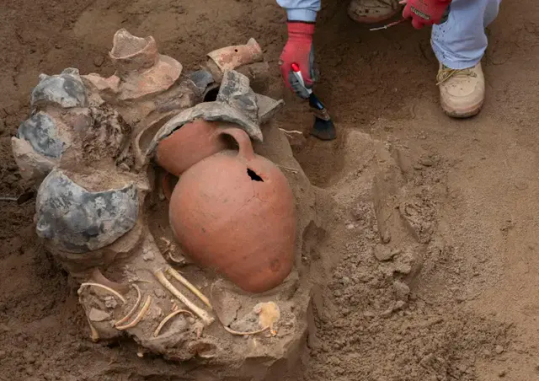
Eight Mummies and Pre-Inca Artifacts Discovered in Peru
Peruvian gas workers made an astonishing discovery beneath the ancient streets of Lima this week — uncovering eight mummies and a number of Pre-Inca artifacts.
“We are recovering those leaves of the lost history of Lima that is just hidden under the tracks and streets,” said Jesus Bahamonde, an archaeologist with Calidda, the company that distributes natural gas to the 10 million residents of Peru’s capital city.
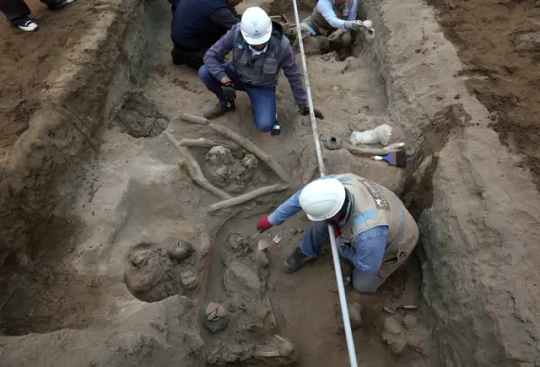
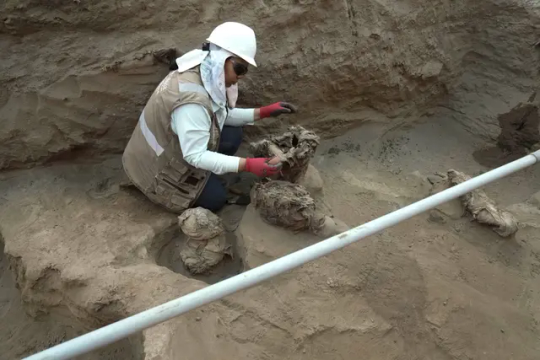
Since the company began expanding its gas line system nearly two decades ago, they’ve racked up more than 1,900 archeological finds — including mummies, pottery, and textiles, Bahamonde said.
In the most recent discovery, the eight mummified males were found bundled up in the trench, wrapped in cotton cloth and tied with ropes braided from vines. Workers found the bodies about a foot below the ground.
Archeologists with the gas company believe the men belonged to a pre-Inca culture called Ichma, which formed around A.D. 1100 and flourished in the valleys around Lima until it was absorbed into the Inca Empire in the late 15th century.
Roberto Quispe, an archeologist who worked in the trench, sad the mummified bodies are likely two adults and six minors.
Lima, now an urban economic hub, has been occupied by humans for more than 10,000 years, from the Pre-Incan cultures to the Spanish conquistadors who claimed the land in the 16th century.
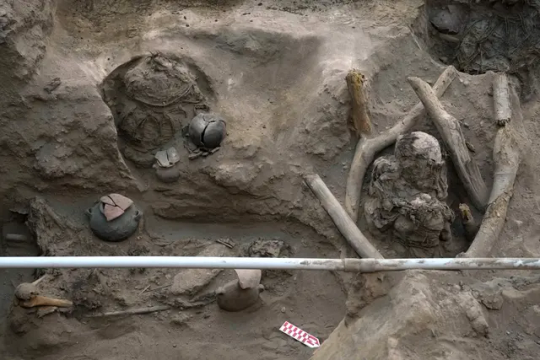
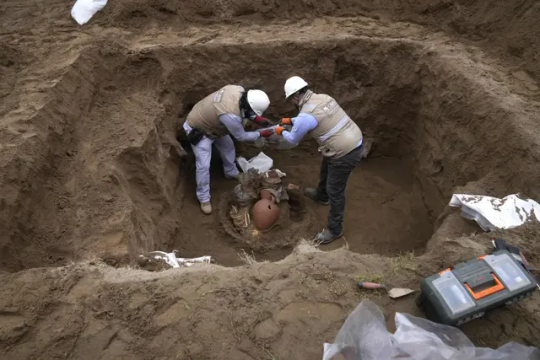
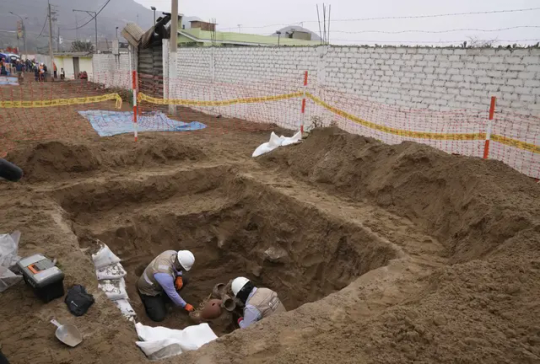
Many archeological finds have proven to be from more recent times.
In 2018, Quispe and other archaeologists working in the La Flor neighborhood found wooden coffins holding three Chinese immigrants buried in the 19th century.
The bodies were found alongside opium pipes, hand-rolled cigarettes, shoes, Chinese playing cards, a Peruvian silver coin minted in 1898 and a certificate of completion of employment contract, written and Spanish and dated 1875.
The eight mummies were found amidst braised chicken restaurants and a road that leads to Peru’s only nuclear power station.
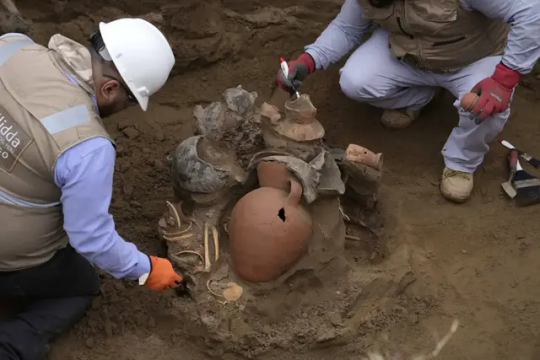
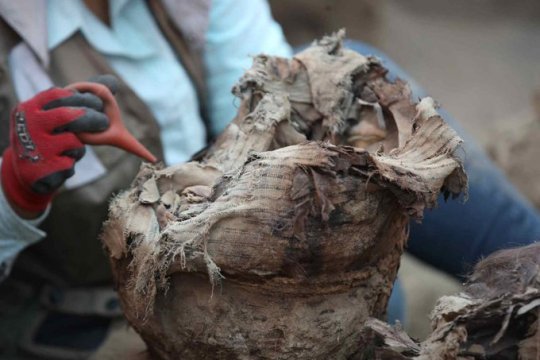

“When the Spaniards arrived in the 16th century they found an entire population living in the three valleys that today occupy Lima … what we have is a kind of historical continuation,” Bahamonde said.
Most of the archaeological sites uncovered by Calidda have been burial sites discovered on flat ground, Bahamonde said.
Aso scattered throughout the urbanized city are more than 400 larger archeological sites, known in the indigenous Quechua language as “huacas,” which are sacred adobe constructions typically found on hilltops.
By Patrick Reilly.

#Eight Mummies and Pre-Inca Artifacts Discovered in Peru#Lima Peru#ancient grave#ancient tomb#ancient artifacts#archeology#archeolgst#history#history news#ancient history#ancient culture#ancient civilizations#Inca history#Ichma history
56 notes
·
View notes
Text
The Nazca mummies recently received a huge amount of publicity when Jaime Maussan presented his version of the story before the Mexican Congress. The weaknesses in this story immediately became an international news sensation. The New York Times picked it up and revealed that a paper has been published discussing the truth about the mummies that Maussan displayed: they are a strange mix of various animal parts, very cleverly constructed–but at least a thousand years ago! Maussan claimed that they were “alien bodies.” US Navy pilot Ryan Graves, who has testified before congress about his own UAP sightings, expressed himself as being “deeply disappointed” by Maussan’s “stunt.”
There is a much bigger story here, and in this special edition of Dreamland, Whitley goes into it with William Galison who, with Theirry Jamin, has been working on the case since 2018. (Whitley has been involved since 2019.) The case has been kept relatively quiet in the interest of completing scientific work on the artifacts.
In this interview, William lays out the history of the Peru project and explains the truth about this world-class mystery. The mummies that Jaime showed are NOT aliens bodies. They are something created a thousand years ago for unknown reasons. But there are other, larger ones that Maussan could not obtain from Peru, which have revealed strange DNA results and anatomy that, under CT scans, does appear to be truly anomalous.
Go deep into what is quite possibly the greatest mystery in modern–or ancient–history with Whitley and William, who are both up on the very latest information from the REAL story.
Visit Theirry Jamin’s alien project website here. Read the scientific paper referred to in the show and the New York Times article here.
1 note
·
View note
Text

Tad the last explorer gender swap ♥️
#tadeo jones#tadeo jones 2#tadeo jones 3#tad the lost explorer#momia#la momia#the mummy#mediaset#españa#recuerdos#infancia#nostalgia#familiar#dibujos#dibujos animados#dibujo tradicional#dibujo#drawing#pencil drawing#genderswap#genderbend#egypt#peru#viral#fanart#fyp#fandom
3 notes
·
View notes

